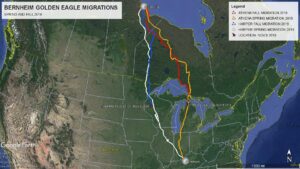By Andrew Berry
Bernheim’s golden eagles are back in communication and have arrived in the U.S. The 10-year research project has been tracking two golden eagles to understand their habits and habitats, migrations, and interactions.
 We’ve studied Harper, a male golden eagle, for the past five years and and Athena, a female, since early 2019. Research showed Harper traveling 1,500 miles between Bernheim Forest and the wilderness of northern Manitoba. As this was Bernheim’s first year tracking Athena, we all anxiously waited to see where her migration would lead, only to have her lose communication before its end. The golden eagles are tracked with solar-powered transmitters that communicate data via cellular towers near towns and human environments. With both eagles back in cellular range, the previous seven months of data have been downloaded and are being analyzed.
We’ve studied Harper, a male golden eagle, for the past five years and and Athena, a female, since early 2019. Research showed Harper traveling 1,500 miles between Bernheim Forest and the wilderness of northern Manitoba. As this was Bernheim’s first year tracking Athena, we all anxiously waited to see where her migration would lead, only to have her lose communication before its end. The golden eagles are tracked with solar-powered transmitters that communicate data via cellular towers near towns and human environments. With both eagles back in cellular range, the previous seven months of data have been downloaded and are being analyzed.
Learning about these rare eastern golden eagles is critical for the protection of this magnificent species. This research project, in partnership with Cellular Tracking Technologies and Conservation Science Global, is demonstrating the importance of large protected areas for this apex predator both in summer and winter. The golden eagle is just one example of animals that migrate between Bernheim and far off locations, including butterflies, bats, raptors, and songbirds. Our research continually shows Bernheim’s 16,137 acres of protected land to be a critical migratory destination for many of these rare, threatened, and endangered species.
We saw Harper and Athena spend last winter in Bernheim roosting together, hunting and feeding together, and defending territory. Then somewhat unexpectedly, the golden eagles began their spring migration heading north on March 11, 2019, choosing separate paths. Athena headed to Michigan and entered Canada at the Straits of Mackinac on the eastern tip of Lake Superior. Harper used his preferred route passing on the western tip of Lake Superior at Duluth, MN. After entering Canada, the golden eagles lost communication for over 200 days while in the wilderness.
The results from Athena’s spring migration that were received this week were a complete surprise. We saw these eagles travel separate migratory paths 350 miles apart, separated by Lake Superior, and then once around the massive barrier of the Great Lakes come back together in northern Manitoba. They spent the remainder of the summer in the vast wilderness near Churchill. Ongoing data analysis will be required before we understand the extent of their interactions during the summer months.
 The eagles are now traveling their individual preferred migratory route and rapidly headed south along with the cold arctic air that is descending into the United States. Harper’s timing is several weeks later than in 2018, when the complete fall migration took just 19 days, beginning on October 16, 2018, and ending on November 3, 2018. This year we saw Harper depart from summer range near Churchill on October 22, 2019, and Athena departed on October 20, 2019.
The eagles are now traveling their individual preferred migratory route and rapidly headed south along with the cold arctic air that is descending into the United States. Harper’s timing is several weeks later than in 2018, when the complete fall migration took just 19 days, beginning on October 16, 2018, and ending on November 3, 2018. This year we saw Harper depart from summer range near Churchill on October 22, 2019, and Athena departed on October 20, 2019.
Big questions remain, and additional data analysis will hopefully reveal whether these birds are a breeding pair. For now, Harper and Athena are the only two individuals that truly know the status of their pair bond. We can say it is complicated, and we are just starting to unravel the mysteries that would allow two golden eagles to form a lifelong partnership. Stay tuned as we follow their movements during migration over the coming weeks. Thank you for the continued interest and support of Bernheim and our golden eagles.

